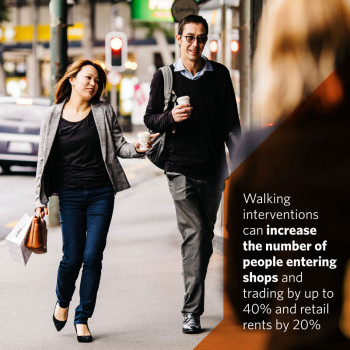
New Zealand has one of the highest rates of car ownership in the world. Improving walkability and therefore reducing the need to use a car for travel has numerous economic benefits.
At 0.77 vehicles per capita (double the car ownership rate of some European countries), with most of the South Island having a car ownership above 0.9 vehicles per capita.[1] This is in part due to urban patterns that favour or require access to a car and limits transport accessibility for the one in eight households with no access to a motor vehicle.[2]
Improving walkability and therefore reducing the need to use a car for travel has numerous economic benefits:
The tourism economy can also benefit:
For information relating to economic assessment of improving walking facilities,see
PNG: Planning and funding
[1] Ministry of Transport. (September 2018). 2017 New Zealand Vehicle Fleet Annual Spreadsheet (version 4)(external link)
[2] Ministry of Transport. (September 2018). Households with access to motor vehicles (external link)
[3] Statistics NZ. (2016). Household expenditure statistics: Year ended June 2016(external link)
[4] Mackie Research. (n.d.). Healthy Future Mobility Solutions(external link)
[5] Litman, T., (2018). Evaluating Active Transport Benefits and Costs(external link). Victoria Transport Policy Institute, Victoria, BC.
[6] Rohani, Mehrnaz & Lawrence, Grant. (2017). The relationship between pedestrian connectivity and economic productivity in Auckland’s city centre.(external link) Second edition. Network scenarios analysis. Auckland Council technical report, TR2017/007-2.
[7] Karnadacharuk, A., Vasisht, P., & Prasad, M., (2015). Shared Space Evaluation: O’Connell Street, Auckland.(external link) Australasian Transport Research Forum 2015 Proceedings, Sydney.
[8] Davis, D. (2015). A Tale of Two Cities: Auckland’s Shared Space programme turns streets into places(external link)
[9] Fleming (Allatt), T., Turner, S. & Tarjomi, L., (2013). Reallocation of road space. Waka Kotahi NZ Transport Agency Research Report 530.
[10] Clavé, S., (2019). Urban Tourism and Walkability, in The Future of Tourism, pp 195-211.
[11] UN World Tourism Organization. (2019). Walking Tourism – Promoting Regional Development(external link)
[12] Hall, M. & Ram, Y., (2019). Measuring the relationship between tourism and walkability? Walk Score and English tourist attractions. Journal of Sustainable Tourism(external link)
[13] Scmidt, J. (n.d.). Revisiting Pedestrian Malls(external link). NACTO
[14] European Commission. (n.d.). Reclaiming city streets for people: Chaos or quality of life?(external link)
[15] Dunedin Visitor Strategy Steering Group. (July 2008). Dunedin Visitor Strategy 2008–2015(external link)